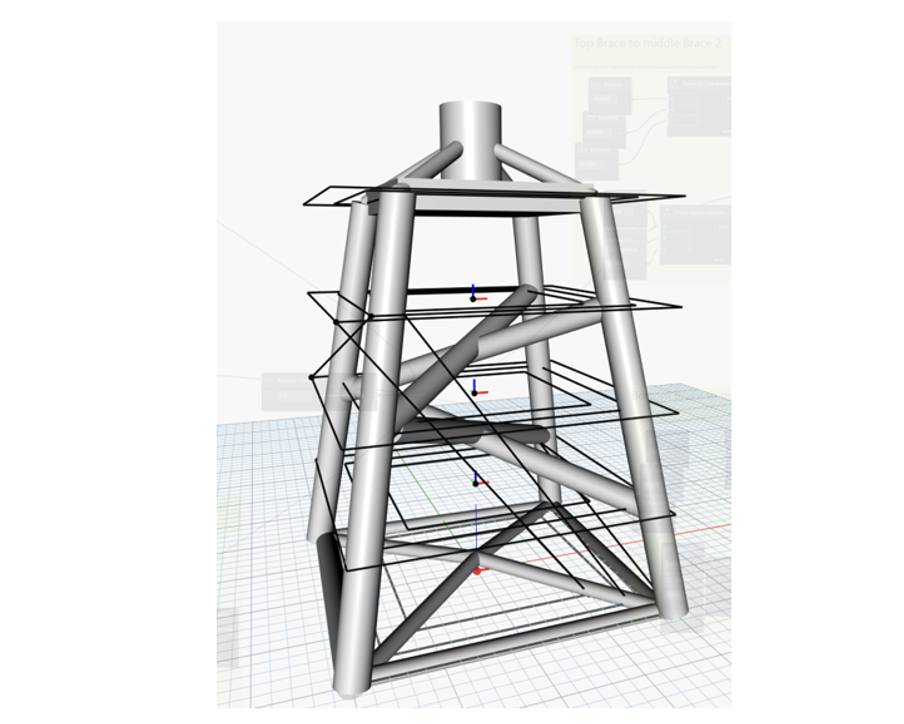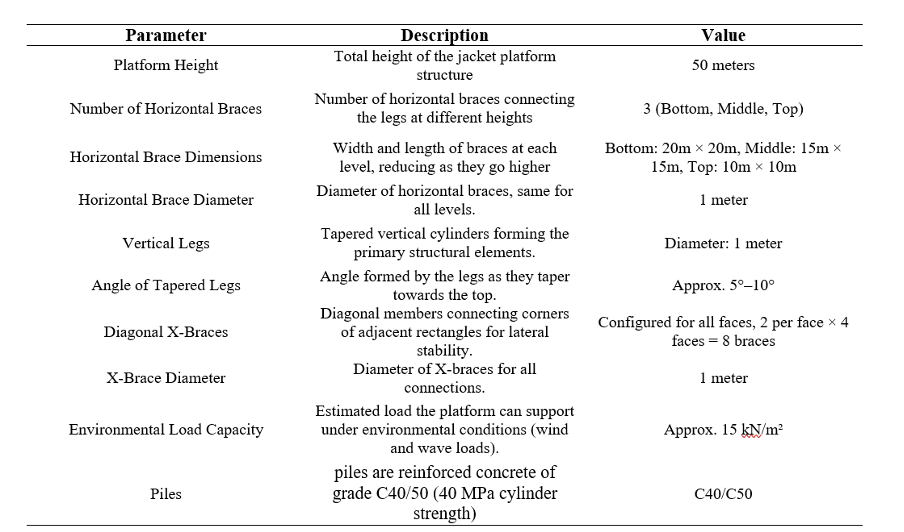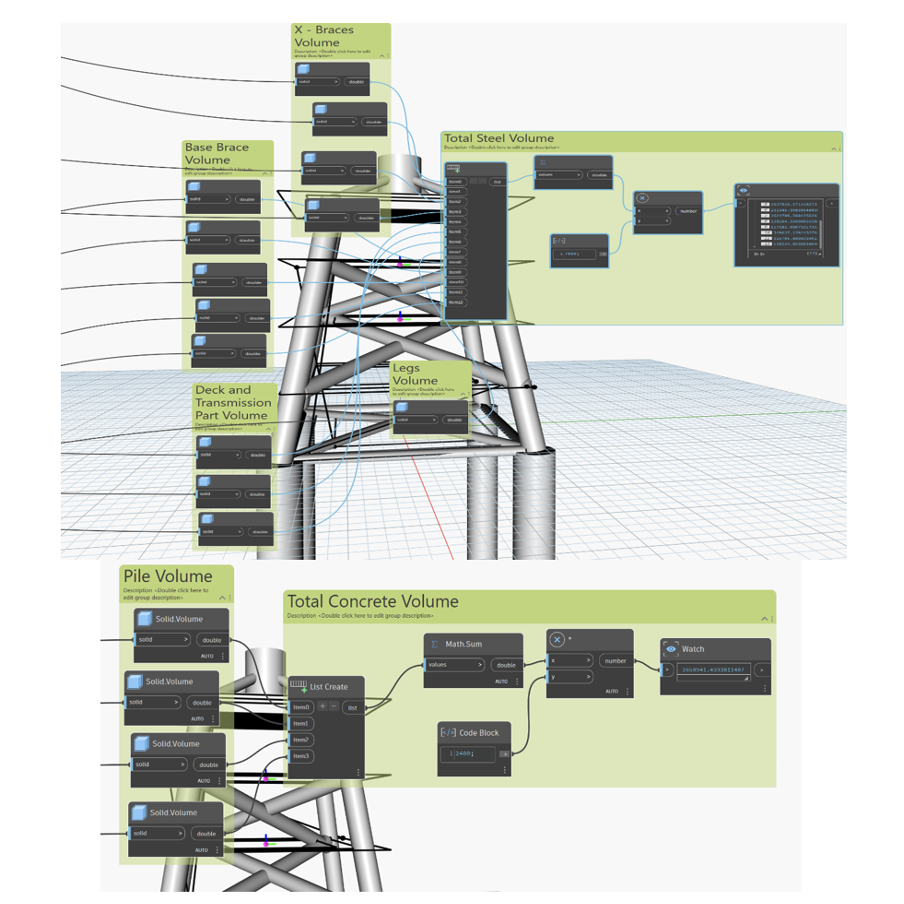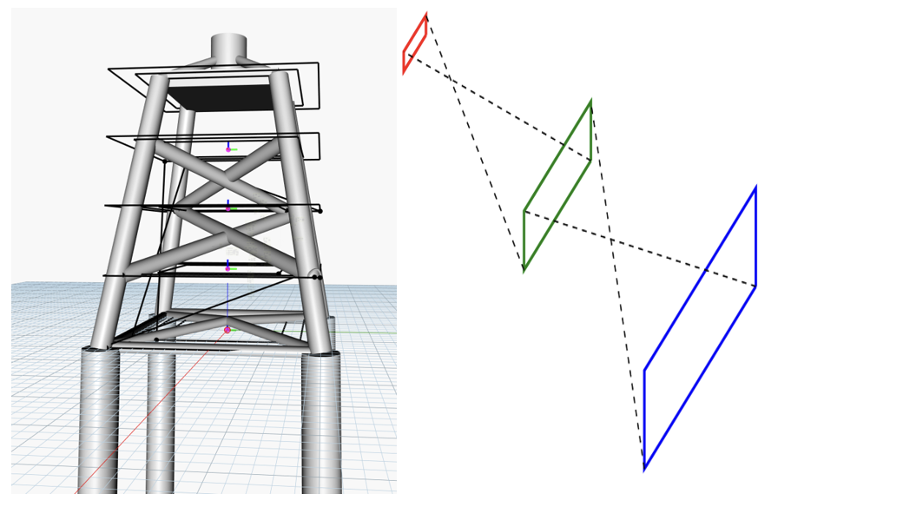This Part focuses on designing a jacket platform structure for offshore wind turbines, optimizing the arrangement of structural elements to minimize material use while ensuring stability under environmental loads. A parametric model in Dynamo enables dynamic adjustments to key parameters, such as the platform height, brace dimensions, and leg angles, facilitating efficient design exploration.
The primary goals of this project are to:
- Minimize the volume of structural material (steel) used in the jacket platform.
- Ensure that structural elements (legs, braces, and horizontal frames) meet established criteria for load capacity, stability, and resistance to environmental forces like wind and waves.
Model Description
This project develops a parametric model for a three-level jacket platform, focusing on structural stability and optimization by dynamically adjusting key design parameters. The model integrates features such as tapered vertical legs, X-braces for lateral stability, and horizontal braces to balance material use and ensure robustness. By leveraging parametric modeling, this approach enables efficient exploration of alternative configurations to achieve an optimal balance between material efficiency and structural performance.
The parameters for the jacket platform were chosen to balance material efficiency and structural stability, guided by relevant design standards and literature. The platform height of 50 meters was set to accommodate typical turbine installations while ensuring a manageable load on the structure, as suggested by offshore design guidelines (DNV, 2020). The horizontal braces at three levels (Bottom, Middle, and Top) were designed with tapering dimensions, reducing as the structure rises, to enhance stability and minimize material use, consistent with principles outlined in the study by Moghadasi et al. (2017). A consistent brace diameter of 1 meter was selected to standardize design while ensuring sufficient strength, following recommendations in tubular structural design (Resch et al., 2016).
The vertical legs were modeled as tapered cylinders with a 1-meter diameter at the base and converging towards the top. The tapering angle of 5°–10° ensures the platform can resist overturning moments caused by wind and wave loads, aligning with findings by Jayasinghe et al. (2022) on optimal geometric configurations for offshore platforms. Diagonal X-braces were added between adjacent rectangles on all four faces of the structure, with 1-meter diameter members, providing critical lateral stability, as noted in Varghese (2009).
The estimated environmental load capacity of 15 kN/m² was determined based on offshore platform standards (API RP 2A, 2019) and ensures the structure can withstand dynamic effects
Design Challenge
To develop the parametric model for the jacket platform, high-performance criteria were identified to guide the design process and serve as measurable benchmarks for evaluating the structure’s performance:
- Material Efficiency
- Objective: Minimize the total volume of steel used in the jacket platform, including legs, horizontal braces, and X-braces.
- Rationale: Reducing material usage lowers construction costs and contributes to sustainability by reducing the carbon footprint of steel production.
- Implementation: Dynamically calculate the total volume of steel for all structural elements using parametric modeling, ensuring material efficiency without compromising stability.
- Structural Stability
- Objective: Ensure the platform’s stability under environmental forces, such as wind and wave loads, by optimizing the geometry and configuration of the structure.
- Rationale: Stability is critical for the safety and long-term performance of the platform in offshore environments, where dynamic forces can significantly impact the structure.
- Implementation: Use tapered vertical legs, X-braces for lateral support, and properly spaced horizontal braces to distribute loads evenly and resist overturning moments.
These criteria ensured that the jacket platform design balances material efficiency with robust structural stability, meeting the demands of a challenging offshore environment
Volumes
The material and volume of the jacket platform were calculated in Dynamo by extracting the geometry of all structural components, including the vertical legs, horizontal braces, X-braces, and piles. Using Solid.Volume, the total volume for each component was determined, with the piles having a height of 30 meters.To calculate material usage, the volumes were multiplied by the respective material densities, such as 2400 kg/m³ for reinforced concrete (piles) and 7850 kg/m³ for steel (legs and braces), ensuring accurate weight estimations for the entire structure.
Experiments with the model
In this section, the design space is explored by experimenting with different parameters of the jacket platform. The goal is to evaluate the effects of varying the number of X-braces, the diameter of braces and legs, and the tapering angle of vertical legs on both material usage and structural stability.
Three offshore jacket platform design options were analyzed, each balancing material usage and structural stability under environmental loads.
- Option 1 (Material Efficiency Focus): This design used 3 horizontal brace levels, 2 X-braces per face, and tapered vertical legs (1-meter diameter, 5°–10° tapering angle). While it minimized material usage, the reduced X-brace density led to lower lateral stability, making it the least stable option.
- Option 2 (Maximum Stability Focus): This option increased horizontal braces to 4 levels, X-braces to 3 per face, and leg diameters to 1.2 meters with a reduced tapering angle. The additional structural reinforcements significantly enhanced lateral stiffness and resistance to environmental loads, but at the cost of higher material consumption.
- Option 3 (Balanced Approach): Maintaining 4 horizontal brace levels and 3 X-braces per face like Option 2, this option optimized material usage by reducing brace dimensions and keeping vertical leg diameters at 1 meter with a steeper tapering angle. This achieved adequate structural performance while limiting material costs.
A comparative evaluation highlights the trade-offs between material efficiency and structural performance. While all options met basic structural criteria (e.g., bending moments and deflection), the model does not account for shear design, crack width limitations, or long-term effects like creep and shrinkage, which are essential for ensuring durability and serviceability in real-world offshore conditions.




